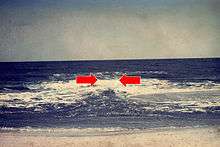Water safety
Depending on the area, there may be several dangers involved in swimming and other activities by the beach, such as tides, currents, wildlife and seabed features, some not obvious. Unless at an organized beach, you should seek local advice.
- Not to be confused with drinking water, which is covered in the "Water" article.
Potential dangers
- At ocean beaches, there are often rip currents that can take a swimmer out to sea, caused by tides or waves (even in still weather). Areas within a mile of straights have pronounced rip currents.
- Drop-offs, due to constantly changing topography.
- Fishing nets, submerged trees and other obstacles could get you trapped.
- Quicksand and other seabed features could have similar effects.
- Jellyfish, sharks and other wildlife
- Tsunamis and storms can be particularly dangerous to people at the beach or out at sea.
Preventing dangers
Remember that if somebody is going to drown because of fatigue, inhaled water or a heart attack, he or she will not have any opportunity to scream, but will just disappear – contrary to what you see on TV. Keep a close look at least on children. Swimming in pairs is a good way to make sure everybody is being watched by somebody at all times.
The warnings on some floating devices, that they may only be used under supervision, are not exaggerated: e.g. swim tubes can turn upside down, creating a very dangerous situation, or take a child to deep water where the child may slip out of it. Proper lifebuoys are differently constructed.

Rip currents are the returning flow from waves breaking off the beach, often at a reef or similar. Due to the underwater topology the return flow is concentrated at a few deeper sections, and a fast current to deep water may form there. Most deaths happen as result of fatigue trying to swim back against the current, which may be impossible. Instead either swim in parallel to the shore, i.e. perpendicular to the current, or just wait it out (calling for help), as it loses its force outside the surf zone. As soon as you get out of the current, swimming back is no more difficult than normally. Try aiming somewhere where you are not caught again or, depending on your skills and on whether you have been noticed, you might want to wait for rescue.
If somebody disappears, watch the point of disappearance closely while calling for help. If others can help, it is better that you direct the help to the right location than that also you lose it by getting distracted.
Unless you have rescue training or are rescuing a small child, always have some device between you and the victim; a person scared of drowning can drag you into the deep. Have a look for possible aids already when arriving: lifebuoys, oars, poles, surfboards etc.